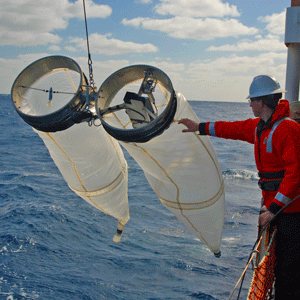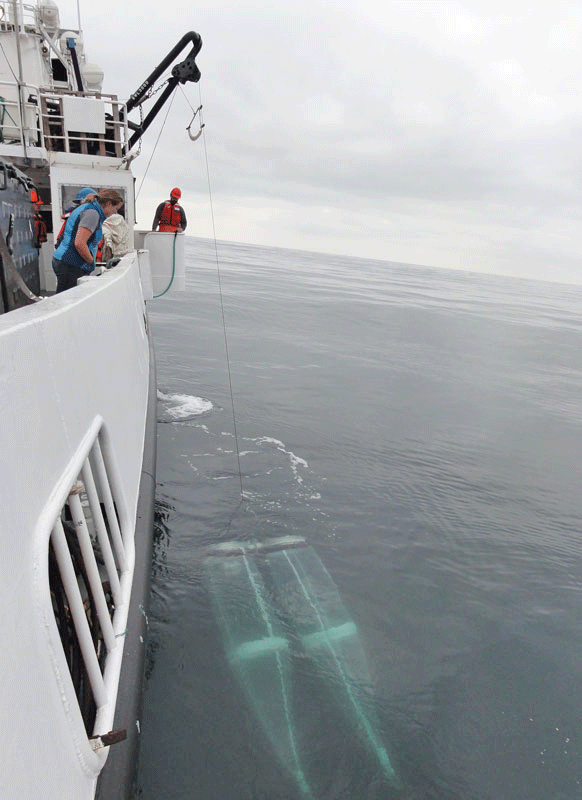 Southwest Fisheries Science Center collects CalBOBL net tow samples for all CalCOFI and SCCOOS stations. The CalBOBL (Bongo) net, referred to as CB in the CalCOFI database, has been the standard sampler since replacing the CAL1MOBL in 1978. The net frame is connected to a central yoke which is swivel-shackled to the winch tow cable. The central yoke makes this sampler a "bridle-free net" which allows the mouth openings to fish horizontally during the oblique tow.
Southwest Fisheries Science Center collects CalBOBL net tow samples for all CalCOFI and SCCOOS stations. The CalBOBL (Bongo) net, referred to as CB in the CalCOFI database, has been the standard sampler since replacing the CAL1MOBL in 1978. The net frame is connected to a central yoke which is swivel-shackled to the winch tow cable. The central yoke makes this sampler a "bridle-free net" which allows the mouth openings to fish horizontally during the oblique tow.
The bongo frame consists of two anodized aluminum circles that are 71 cm in diameter and has a 505 µm mesh net, 3 meters in length, attached to each side. The bongo is towed obliquely through the water column from 210 meters to the surface, while the ship is underway at 1-2 knots. While underway, a fixed amount of towing cable is paid out (300 m); the net is held at depth for 30 seconds and then retrieved at a constant rate (20 m/min). Ship speed is adjusted to maintain the towing cable at a constant angle to the vertical (45 degrees +/- 3 degrees). In shallow areas the amount of towing cable paid out is adjusted so the net samples approximately 15 m off the bottom. Starboard side the bongo sample is preserved in formalin and the port side sample is preserved in ethanol.
A Laser Optical Plankton Counter (LOPC) is deployed in the CalBOBLnet and is used to assess distribution, abundance, and size of zooplankton and other particles. The LOPC is mounted with an external battery pack and CTD in one side of the CalCOFI bongo net. The LOPC senses particles > ~ 100 microns equivalent spherical diameter (ESD) as they pass through a 1-mm thick sheet of red light in a 7cm x 7cm tunnel. The ESD of particles that occlude one or two 1mm x 1mm optical elements ('single element particles', SEPs) are accumulated by size bins in histograms every 0.5sec. Size and transparency of particles that occlude three or more optical elements ('multiple element particles', MEPs) are recorded as they are encountered and used to estimate their ESD. Combined ESD for all particles provides a depth-resolved size spectrum of zooplankton and other particles in the sampled water column for comparison with the zooplankton collected simultaneously in the CalCOFI bongo net. From the combined LOPC and net-derived data, inference is made about the distribution, abundance, size, and type of zooplankton and other particles. It is noted that inference about particle type is limited, especially for small particles for which only ESD is known; size and transparency data for larger particles allow inference about relatively transparent aggregates and relatively opaque zooplankters.
 |
Additional Information |
 |
